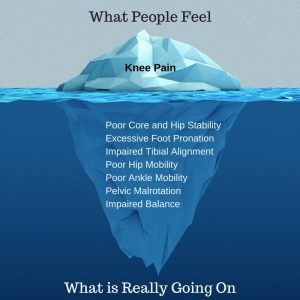Why You Can’t Chase Symptoms When Treating Pain
 By: Dr. Rachel Jakubowski
By: Dr. Rachel JakubowskiPhysical Therapist
SPECTRUM, Inc
One of the first things a physical therapist will ask when a client walks into the treatment room is: Where is your pain? We need to know this of course because it is what brought you into therapy but it is only a small piece of information in the larger puzzle which is: why do you have knee pain in the first place?
 When treating pain, a lot of clinicians run the bad habit of solely focusing their assessment and treatment directly on the location of pain. The issue with this is something called regional interdependence, which refers to “seemingly unrelated impairments in a remote anatomical region that may contribute to, or be associated with, the patient’s primary complaint.” In other words, pain at your knee isn’t always directly related to a problem at the knee. Knee pain can stem from problems at your hip, your ankle, core strength/stability, tibial alignment, pelvic alignment, and the list goes on and on.
When treating pain, a lot of clinicians run the bad habit of solely focusing their assessment and treatment directly on the location of pain. The issue with this is something called regional interdependence, which refers to “seemingly unrelated impairments in a remote anatomical region that may contribute to, or be associated with, the patient’s primary complaint.” In other words, pain at your knee isn’t always directly related to a problem at the knee. Knee pain can stem from problems at your hip, your ankle, core strength/stability, tibial alignment, pelvic alignment, and the list goes on and on.
So when you hear your trainer or physical therapist say– “It’s all connected,” they aren’t lying to you.
This is why it’s extremely important for you to seek a physical therapist or other health care professional who is competent in assessing the entire body instead of focusing solely on where you feel your pain.
Let’s give another example… a lot of people come to me complaining of muscle knots and pain between the shoulder blades. You tend to see these people constantly trying to massage or rub their neck/upper back with their hand, or posting up against a doorway like bear scratching its back on a tree.
When I treat these people I might perform a few minutes of soft tissue massage directly on their painful muscle knots, but I end up spending more time performing manual on the front aspect of their shoulder. Common dysfunctions I see in this group of people are: restricted thoracic (upper spine) mobility, restricted neck mobility, restricted musculature around the shoulder joint (specifically the pectoralis muscles, latissimus dorsi, rotator cuff muscles, etc), poor shoulder and core strength/stability.
That’s a lot of stuff right! Seems overwhelming but most people have muscle knots between their shoulder blades, it’s just whether or not those knots are inflamed or aggravated. Slouching constantly while sitting at your desk not only leads to your shoulders and neck tightening up but also causes your shoulder and back muscles to become weaker. This tends to overwork the muscles between your shoulder blades, leading to irritation and activation of these painful muscle knots. Thus by effectively addressing the root problems mentioned above, you can treat the area experiencing pain without even touching the knots directly.
When I assess an individual for any type of pain I check each body part and I formulate a list of “dysfunctions” specific to the person…kind of like a check list for that person. I then strategically treat these areas of dysfunction, slowly checking items off of the list.
3 important components I look at are:
1. Mobility
2. Stability/Motor Control
3. Strength
The first issue I target are mobility issues. If you have poor flexibility or joint range of motion then your ability to move becomes impaired. So before I make you move I want to make sure you have the mobility to do so. Having full range of motion, within normal standards, will also allow for what we call good proprioception. Proprioception refers to the ability of the body to sense where it is in space. In essence, is your elbow bent or straight? Are your feet flat on the ground? Is your shoulder raised over your head or is it resting by the side of your body? When you lack range of motion in a joint, your body’s ability to sense where that joint is in space becomes impaired and therefore becomes less stable during movement.
The next area I focus on during treatment is stability/motor control. Stability/motor control refers to your body’s ability to engage/fire the appropriate muscles during movement, as well as your body’s ability to move limbs through space. People typically have stability/motor control dysfunctions related to poor deep inner core engagement. Your pelvic floor, diaphragm, and transverse abdominis function to stabilize the trunk during movement, so when one of these areas become impaired your body will reflexively try to get stability from somewhere else. When it does these people will often complain of stretching all of the time but never feeling loose.
There is another group of people that have full range of motion but their body just doesn’t know how to engage the right muscles to move in space. I tend to think of that one tall skinny kid in gym class with gumby-like limbs. They are flexible but have the worst coordination you have ever seen; get them to rub their tummy with one hand while tapping their head with the other and they end up punching themselves in the face.
Once the mobility and stability aspect is addressed and your foundation is now stable, you can then add strengthening components on top. Just like a building, if you place too much load on on top of a faulty foundation, the building will eventually crumble.
Step by step progression of how I assess and treat my patients:
1. Thorough gathering of patient history: When did your pain start? Did an incident occur that triggered the pain? What activities cause pain? What relieves your pain? etc.
2. Your goals for therapy: to run without pain, pick up your kids without pain, to be able to sleep at night without being woken up by pain, etc.
3. Full body movement assessment: each body part is assessed for mobility, stability and strength
4. A list is comprised of any mobility, stability or strength issues specific to the individual
5. Mobility is addressed with active release techniques, joint mobilizations, trigger point therapy, myofascial release
6. Stability/Motor Control issues are addressed through exercise and patterning to facilitate neuromuscular reeducation
7. Comprehensive home exercise program with videos demonstrating exercises are provided via email to address movement dysfunctions at home
8. Reassess next session and move onto different problem on client’s problem list
With an in depth and thorough examination, treatment becomes more precise and individualized to the patient’s actual needs. This means quicker results and less time spent at therapy.
If you would like to speak to me directly or set up a free 20 minute assessment to learn more about your pain, please call 321-218-0435. You can also email me at jakubowski@spectrumsp.com.
Leave a Reply